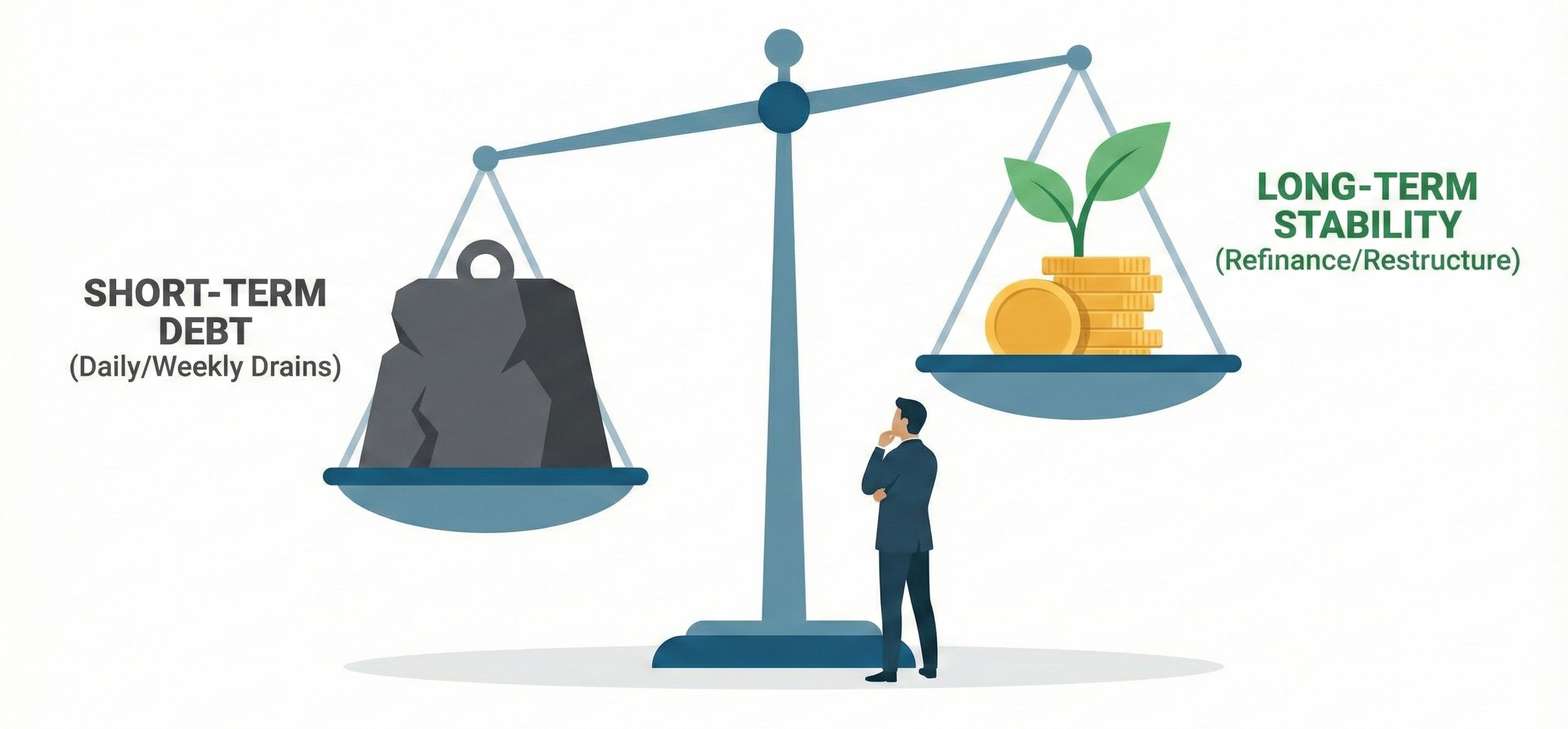A significant business threat is currently operating within the modern financial landscape, one that targets your ambition and your periodic need for business capital: the proliferation of opportunistic lenders selling what amounts to a financial death trap.
These entities, frequently operating outside the sphere of traditional banking, are making it "WAY TOO EASY" for businesses to borrow money. In doing so, they are systematically setting up countless dedicated entrepreneurs for financial failure.
This problem extends far beyond merely high interest rates; it involves a fundamentally flawed and destructive underwriting philosophy based primarily on top-line cash flow, completely ignoring the critical metrics of profitability, EBITDA, or the genuine capacity to service debt payments.
This article serves as a crucial warning, a thorough examination of this modern lending squeeze and a guide to financial self-protection for every small business in the United States.
The Lure of "Fast Cash" and Fundamentally Flawed Underwriting
The appeal of these non-traditional funding sources is extremely strong, often proving almost irresistible to a business facing an immediate cash shortfall or a sudden, unexpected growth opportunity.
Traditional banks must adhere to strict regulatory standards, which necessitate comprehensive financial reviews, collateral requirements, and an in-depth analysis of a business's operational history, credit profile, and, most importantly, its profitability.
This process is typically slow, demanding and results in a high rejection rate for smaller, younger, or businesses without significant tangible assets.
In sharp contrast, opportunistic lenders present a swift alternative. Their application procedures are usually quick, approval times are measured in hours, and their principal—often only—criterion for lending is gross daily or monthly revenue.
They simply observe the total money flowing into your business, usually through a quick review of your business bank account or merchant processing statements, and base the loan amount on a simple multiple of that gross income. They do not scrutinize your financial statements to determine how much of that revenue remains after paying for inventory, payroll, overhead, and operating costs—the actual profit.
They lend based on the incoming total volume, not the net health of the business.
This model represents a dangerous and fundamental deviation from responsible financial practice. It completely disregards the debt service coverage ratio (DSCR), which is the essential measure of a borrower’s ability to repay debt from sustainable, actual operational earnings.
Essentially, they offer quick cash to businesses already under stress, charging an exorbitant fee for a temporary fix that rapidly drains the business's liquidity.
The Fatal Flaw: Disregarding Profitability and EBITDA
Consider a business with one million dollars in annual gross revenue. To an opportunistic lender, this is a strong indicator, potentially justifying an advance of one hundred thousand to two hundred thousand dollars. Now, consider that the same business operates on an extremely narrow margin—perhaps two percent net profit—due to high costs of goods sold and rising operational expenses. That one million in revenue translates to only twenty thousand dollars in actual, usable net profit, or Earnings Before Interest, Taxes, Depreciation, and Amortization (EBITDA), which is what is truly available to service debt.
When the lender structures the repayment as a daily or weekly automatic ACH withdrawal—a fixed percentage of that high-volume, yet low-margin, gross revenue—the business is immediately forced into repaying a debt that is completely unsupported by its genuine financial health.
The repayment schedule, often structured as a Merchant Cash Advance (MCA) or similar revenue-based financing, takes a fixed portion of the gross receipts before the owner can pay their fundamental operating expenses.
The business owner quickly faces a severe liquidity crisis, where they have consistent revenue flow but insufficient net cash to cover crucial operating bills. This is the heart of the debt trap. The money is easily obtained because the lender has designed the deal to prioritize their immediate, high-speed repayment, regardless of whether that repayment forces the borrower toward insolvency.
They are not supporting growth; they are betting on temporary gross cash flow with terms designed to extract principal and astronomical fees at a destructive velocity.
The Crippling Effect of Daily and Weekly Repayments
One of the most destructive characteristics of this opportunistic lending is the repayment structure itself. Unlike traditional term loans, which typically require a predictable, monthly installment, these agreements often mandate daily or weekly automatic ACH debits from the business's bank account. The sheer frequency of these payments severely compounds the financial pressure, transforming a manageable monthly liability into an all-consuming, day-to-day struggle for operational survival.
This constant, rapid extraction starves the business of essential working capital, which is the lifeblood required for seamless daily operations. Consider the critical needs immediately compromised: the ability to purchase new inventory, make timely payroll deposits, cover unexpected utility spikes, or fund necessary equipment maintenance. Every dollar is immediately funneled toward debt service. For a small business, the cash flow cycle is already a delicate balance, particularly for those with seasonal variations or extended accounts receivable periods. A daily drain on gross revenue completely shatters this equilibrium.
The business is frequently forced into a devastating spiral. Strained for cash due to aggressive daily payments, the owner often feels compelled to seek another, even more expensive, short-term advance just to meet a payroll deadline or a critical supply order. This process is known as debt stacking.
This second, or even third, loan exponentially increases the problem, creating a financial vortex from which it becomes nearly impossible to escape. It is a self-perpetuating, high-cost debt cycle designed for the rapid return of funds to the lender, indifferent to the borrower's long-term viability. The small business itself is the entity being crushed, sacrificed for the quick, high-yield profits of the non-traditional lender.
The Business Debt Stacking Phenomenon: A Self-Fulfilling Crisis
The absence of underwriting based on actual profitability creates an environment that encourages debt stacking. A lender that focuses solely on gross revenue makes it easy for a business owner to qualify for a new advance, even if they are already servicing one or more of these expensive, high-velocity obligations. Because these non-bank lenders often do not report their transactions to standard business credit bureaus in the same manner as regulated banks, subsequent lenders may not have a complete or accurate picture of the total, crushing debt burden.
A business owner, feeling the intense cash flow constriction from the daily or weekly payments of the first advance, might panic and approach a second, or even a third, opportunistic lender. The new lender sees the gross revenue, disregards the already strained net income, and readily provides more capital—at equally or more punishing terms—to supposedly "resolve" the immediate liquidity problem. This only serves to dramatically intensify the financial pressure. The daily or weekly withdrawals from multiple lenders quickly reach a level that consumes virtually all of the business’s incoming cash flow.
In this dire scenario, the business's primary operational focus shifts from serving customers and achieving market growth to becoming a mere engine for debt repayment. The entrepreneur effectively becomes a high-cost debt collector for their lenders, funneling all earned revenue directly into servicing an unsupportable debt load.
The long-term health, capacity for investment, and future growth potential of the enterprise are entirely compromised, leading inevitably toward financial distress or closure. This entire phenomenon is a direct, foreseeable, and tragic outcome of lending based on gross revenue without any genuine concern for net profit.
The Regulatory Oversight Gap and Lack of Pricing Transparency
A major factor enabling this predatory environment is a significant regulatory gap within the United States. While consumer lending is subject to strict rules requiring the disclosure of Annual Percentage Rates (APR) and other consumer protections, small business lending, especially in the non-traditional finance sector, frequently operates with limited oversight.
Many of these revenue-based financial products are meticulously structured not as "loans" but as "purchases" of future receivables (e.g., Merchant Cash Advances), a legal distinction that allows them to bypass state usury (interest) laws and standard lending disclosure requirements.
This deliberate legal manipulation enables opportunistic lenders to conceal the genuine cost of the capital. Instead of an easily understandable and comparable APR, they often quote a "factor rate" or a "fixed cost." For the typical small business owner, comparing a factor rate of, for example, 1.35, to a traditional bank APR of 8% requires specialized financial knowledge they should not need to possess under financial duress. A factor rate of 1.35 means a borrower who receives one hundred thousand dollars must repay one hundred and thirty-five thousand dollars. When that repayment is aggressively enforced through daily debits over a short, six-month term, the true effective APR can easily exceed one hundred percent.
The profound lack of standardized, clear, and mandated financial disclosure leaves small business owners extremely vulnerable to predatory pricing. They are often unable to fully comprehend the true, debilitating cost of the capital they accept until the daily repayments have already begun to strangle their cash flow. Greater transparency and regulatory intervention, requiring clear, uniform disclosure of the actual APR, are absolutely essential to protecting Main Street businesses from these sophisticated financial maneuvers.
Crushing the Engines of U.S. Economic Growth
The widespread proliferation of these opportunistic lending practices has a profoundly damaging effect that extends far beyond the immediate financial statements of any single small business. Small and medium-sized enterprises (SMEs) are the primary source of vitality for the U.S. economy, responsible for creating the vast majority of net new jobs and driving local economic stability. When a small business is burdened by unsustainable debt, its function as an economic driver is immediately compromised.
Instead of hiring additional staff, investing in new equipment, expanding into a larger facility, or developing new products, the business is forced into a prolonged state of financial contraction. All available investment capital is diverted to excessive, high-cost debt service. Innovation grinds to a halt. Job creation reverses. This systemic financial pressure on individual businesses translates directly into a broader, measurable economic headwind. These lenders are not just harming balance sheets; they are systematically diminishing the growth potential and dynamism of communities across the nation.
Every single business failure attributable to this unsustainable debt represents the loss of a local service provider, a neighborhood employer, and a contributor to the local tax base. The cumulative negative effect of thousands of these failures poses a significant, often overlooked threat to the overall health and entrepreneurial spirit of the American economy. It is a slow-motion crisis where the pursuit of extreme, short-term profit by a handful of non-traditional lenders fundamentally undermines the long-term prosperity of the entire nation.
Entrepreneur’s Essential Self-Defense Toolkit
The most important step in financial self-defense is education and extreme caution. Small business owners must approach the search for capital with the same rigorous due diligence they apply to any major strategic decision. Before agreeing to any financing terms, you must demand to know the true Annual Percentage Rate (APR) of the financing. If a lender refuses to provide it, or offers only a factor rate without a clear APR equivalent, this must be treated as a catastrophic red flag.
Second, you must possess a complete understanding of your business’s actual financial capacity. Do not rely solely on gross revenue projections. Calculate your business's EBITDA and, critically, your Debt Service Coverage Ratio (DSCR). The DSCR determines precisely how much of your sustainable earnings are available to comfortably service the new debt. A financially healthy business should maintain a DSCR comfortably above 1.25.
If a new loan pushes your projected DSCR below this threshold, you are entering a danger zone, regardless of how quickly your gross revenue is increasing. Seek counsel from an accredited financial professional or a resource affiliated with the Small Business Administration (SBA), such as a Small Business Development Center (SBDC), to perform this critical analysis.
Third, you must exhaust all traditional and regulated financing avenues first. This includes local community banks, credit unions, and U.S. Small Business Administration (SBA) guaranteed loan programs. While the application process may be longer and more demanding, the resulting terms will be far more sustainable and protective of your business’s long-term solvency. Never allow the immediate pressure for cash to compromise your judgment regarding the long-term cost. The deceptive convenience of "easy money" almost always conceals a crippling financial burden.
Call to Action: Protect Your Business Future
This message is intended not to incite fear, but to provide actionable empowerment. The financial pressure exerted by opportunistic lenders who make capital "too easy" to borrow is a concrete reality, and the disastrous consequences of their flawed underwriting model—which prioritizes top-line cash flow over genuine profitability—are destroying countless small businesses. By lending without regard for a business's true capacity to service the debt from its net earnings, these entities are actively compromising the stability of individual enterprises and, by extension, the larger American economy.
The future sustainability of your business hinges on your ability to make sound, responsibly underwritten financial decisions. Reject the allure of the quick fix, demand complete financial transparency, and always prioritize the long-term health of your balance sheet over short-term capital convenience. Your business deserves a partner who is genuinely invested in your sustained growth, not one whose business model profits from your eventual failure. By equipping yourself with comprehensive financial literacy and insisting on ethical lending principles, you reclaim control and ensure your enterprise remains a successful, profitable engine of the U.S. economy, avoiding the fatal embrace of the debt trap.
What is the Best Way to Deal with Business Debt Payments that are causing Business Cash Flow issues?
It is NOT by stopping ACH payments.
It is NOT by taking on another business loan.
It is NOT ALWAYS a Refinancing
It is NOT by entering into a debt settlement program.
Find out the BEST strategies to get your Business back to where it was






























